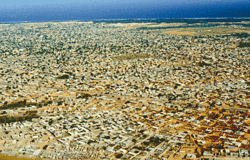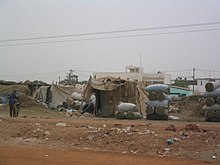Pikins
| Ville de Pikine Pikine |
||
|---|---|---|
|
|
||
| Coordinates | 14 ° 45 ′ N , 17 ° 24 ′ W | |
| Basic data | ||
| Country | Senegal | |
| Dakar | ||
| Department | Pikins | |
| ISO 3166-2 | SN-DK | |
| height | 9 m | |
| surface | 86.8 km² | |
| Residents | 1,170,791 (2013) | |
| density | 13,488.4 Ew. / km² | |
| Website | villedepikine.sn/website/ (French) | |
|
Aerial view of Pikine
|
||
Pikine is as Ville de Pikine , a major city in the Dakar region , the most populous region of the country. The city has its own department, the Pikine department as one of 45 departments that make up Senegal and one of four departments that make up the metropolitan region of Dakar . Pikine has developed from a suburb on the outskirts of Dakar into a city of over a million people, whose population has just outstripped that of the metropolis of Dakar since the 2013 census.
geography
Pikine is a neighboring city to the east of Dakar in the bottleneck of the Cap-Vert Peninsula , which tapers down to 4.6 kilometers , the north bank of which is characterized by coastal dunes and in the hinterland of which the wetlands known as Niayes line up , which are partly populated and partly location many outdoor nurseries are. In the north-west of the city, a distinction must be made between the Grande Niaye de Pikine on the border with Guédiawaye , the Niaye de Thiaroye and the Niaye de Yeumbeul , the last of which continues in three large lakes beyond Malika to the north-eastern city limits. In 2018, the Grande Niaye de Pikine was classified as a protected wetland by the Ministry of the Environment and Sustainable Development and inscribed on the list of areas protected under the Ramsar Convention of 1971. The Technopole urban development project was implemented in the middle of the Grande Niaye even before it was placed under protection .
history
The city was founded in 1952 by the former French colonial government, who relocated Dakar residents to what is now called Old Pikine . Extensive suburbs formed around it. Pikine received city rights in 1983. The accelerating population growth is caused, among other things, by rural exodus due to desertification in large areas of Senegal.
The neighboring towns of Yeumbeul , Thiaroye , Mbao , Keur Massar and Malika became part of the Ville de Pikine in 1996 , while the neighboring town of Guédiawaye was spun off from the department in 2002. The Ville de Pikine was divided into 16 communes d'arrondissement when it was founded .
When the city was founded in the 1950s, there were no floods in the Pikine area, and when precipitation declined across the country in the 1970s and the rural population increasingly moved into the cities, the wetlands in the hinterland of the coastal dunes were particularly sought-after settlement areas. As the development became more dense, the natural vegetation disappeared more and more, the wetlands were constricted and fragmented and the dunes receded. As a result, there were again years of heavy rainfall and the first floods in populated depressions in 1989 and finally several times since 2005. The districts Djidah Thiaroye Kao , Yeumbeul Sud , Yeumbeul Nord and Keur Massar were particularly affected . In 2008, thousands of residents were evacuated from buildings illegally constructed in wetlands. Since then, measures have been taken to protect the population and to channel heavy rain without damage.
population
Population censuses showed the following population figures for the department:
| year | Residents |
|---|---|
| 1955 | 7,600 |
| 1960 | 71,780 |
| 1976 | 298,661 |
| 1988 | 622.172 |
| 2002 | 768,826 |
| 2013 | 1,170,791 |
From this series of numbers it is easy to deduce how a city of over 50 years will develop out of nothing.
structure
Département has an area of 86.8 km². Administratively it consists of three arrondissements, which in turn are divided into 16 communes d'arrondissement:
| Sub-area | Residents 2013 |
| Arrondissement des Niayes | 499 118 |
| Yeumbeul North | 168 379 |
| Yeumbeul Sud | 96 956 |
| Malika | 32 130 |
| Keur Massar | 201 653 |
| Arrondissement de Pikine Dagoudane | 328 673 |
| Pikine Ouest | 52 154 |
| Pikine Est | 32 452 |
| Pikine North | 46 780 |
| Dalifort | 30 418 |
| Djidah Thiaroye Kao | 96 952 |
| Guinaw Rail North | 30 058 |
| Guinaw Rail Sud | 39 859 |
| Arrondissement de Thiaroye | 342 999 |
| Thiaroye sur Mer | 52 773 |
| Tivaouane Diacksao | 40 561 |
| Diamaguène-Sicap Mbao | 128 512 |
| Thiaroye Gare | 24 834 |
| Mbao | 96 320 |
| Ville de Pikine together | 1 170 791 |
The settlement core of Alt-Pikine is divided into the urban districts Pikine Ouest, Pikine Nord, Pikine Est, Guinaw Rail Nord and Guinaw Rail Sud. In 2013 these had a total of 215,629 inhabitants.
Transport and infrastructure
Due to its geographical location, Pikine is the bottleneck for west-east traffic between the metropolis of Dakar and the rest of the country. This flows on the four-lane national road N 1 and the four- to six-lane developed and toll road 1 (Dakar - Diamniadio ) through the city. The Dakar – Niger railway runs parallel to this .
One of the largest companies in the country, the Industries chimiques du Sénégal (ICS), is located in Pikine .
Personalities (alphabetical)
- Amath Ndiaye Diedhiou (* 1996), football player
- Abdou Khadre Guirassy (* 1989), football player
- Mamy Ndiaye (* 1986), soccer player
- Christian Sagna (* 1982), football player
See also
Web links
- Ville de Pikine on the Internet
- City playing fields: Football and youth policy in Senegal since 1950. By Susann Baller. Published by Böhlau 2010, pp. 170-193 in the Google book search; Presentation of the urban development of Pikine and Guédiawaye (German, excerpts from reading)
- Départment Pikine at Geonames
- Pikine at Geonames
Individual evidence
- ↑ Aminata Diop: Dynamique de l'occupation sol dans des niayes de la région de Dakar de 1954 à 2003: examples de la grande niaye de Pikine et de la niaye de Yembeul. Dakar 2006
- ↑ Dakaraktu of October 8, 2018: Technopole. La "grande Niaye" de Pikine-Guédiawaye classée zone humide protégée
- ↑ The problem of the assainment in the department of Pikine. By Abdou Khadir Diop. Dakar, 2010
- ↑ UNHCR: "Senegal: Thousands displaced from their Dakar homes"
- ^ Wetlands international: Pourquoi les inondations à Dakar? 14-Jul-2006 ( Memento from April 15, 2017 in the Internet Archive )
- ↑ La Banque mondiale, February 3, 2016: Vers une gestion durable des risques d'inondations dans la banlieue de Dakar
- ↑ La croissance des grandes villes en Afrique de l'ouest. Examples de Dakar, Abidjan and Nouakchott. Paris 1989 Figures before 2002 according to page 5 of the PDF file 1.57 MB
- ↑ L'AUP en Afrique de l'Ouest: les villes de Dakar et Cotonou, limites et potentialités, page 112 of the PDF file 5.65 MB
- ^ Service Régional de la Statistique et de la Démographie de Dakar: Situation economique et sociale regional 2013, pages 20, 21 and 128 of the PDF file 1.44 MB
- ↑ Historique du développement spatial de Dakar in Monographie de Dakar 2014 Alt-Pikine as a dark brown area on the map on page 14 of the PDF file 4.4 MB




